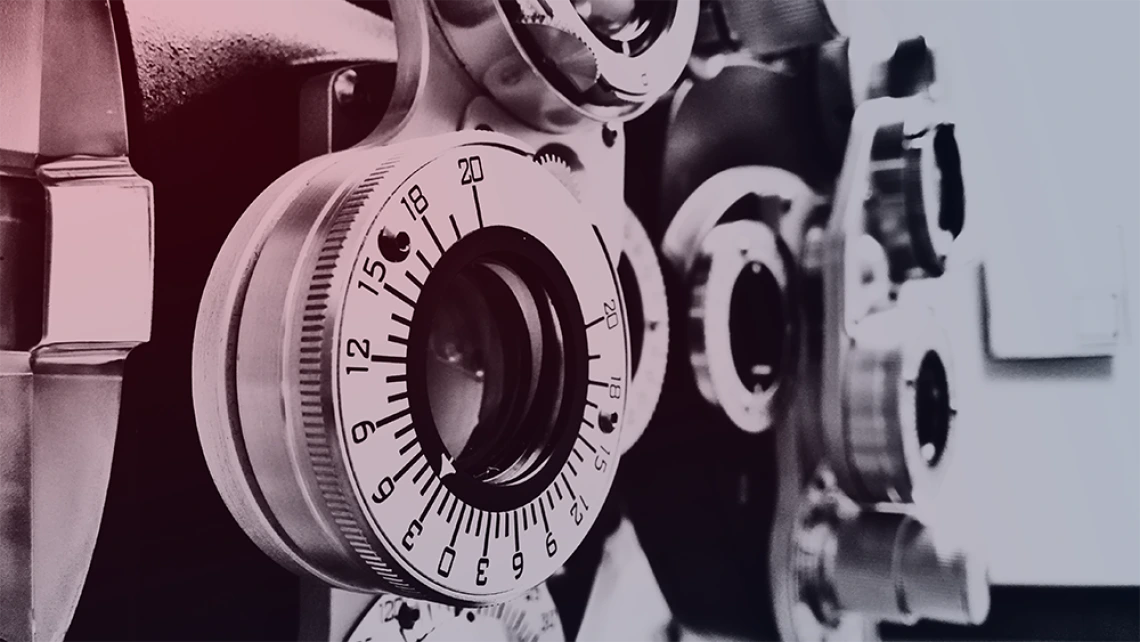Tech Blog: New Fluidic Lenses to Speed or Eliminate "Better One or Better Two" Phoropter

|
Watch the new episode of Invented Arizona, where Jim Schwiegerling set out to replace the current procedure of focusing on a patient’s prescription.
|
Funded by the National Eye Institute in the National Institutes of Health, the National Science Foundation, and Tech Launch Arizona, Jim Schwiegerling, PhD, professor at the University of Arizona College of Optical Sciences has developed a series of lenses that might shorten your trip to the eye doctor.
We had the opportunity to chat with Dr. Schwiegerling, and he walked us through the process of developing his fluidic lenses and how they will replace the current procedure of focusing on a patient’s prescription.
TLA: You’ve been working on this project for quite a while. Can you tell us a little about the background of your invention?
Schwiegerling: We have been working on this project since about 2008. We developed a series of fluidic lenses that can adjust their focal length by pumping fluid in and out of a chamber with a deformable membrane. The concept is fairly old, but one of the novel bits we added was to adjust the shape of the aperture of the lens. We use spherical apertures to create spherical lenses and rectangular apertures to create cylindrical lenses. By stacking fluidic lenses, we can create adjustable lenses that correct for myopia, hyperopia and astigmatism of the eye. The other novel bit is that we combined the fluidic lenses with a wavefront sensor. This device automatically measures the errors of the eye and then can pump fluid into the lenses to compensate for the errors. In effect, the system automatically detects the eyes’ refractive errors and corrects them.
TLA: Sounds like a great advance, but how does it differ from what the current standard of care—the phoropter—provides? What problem does it solve?
Schwiegerling: For anyone who has been to the eye doctor, one of the issues with getting your prescription measured is the time that it takes. The procedure systematically puts a series of lenses in front of the patient and the doctor asks, “better one or better two?” Depending on the patient’s response, the lenses are adjusted, and the process is repeated, often 10 or 20 times to slowly dial in to the patient’s prescription. Our device eliminates the phoropter, the device with wheels of lenses in it, that the doctor uses to determine your prescription and replaces it with a compact fluidic lens stack that effectively achieves all the different prescriptions by pumping in the proper amount of fluid. Furthermore, the wavefront sensor measures the eye and eliminates the need for the patient feedback and instantaneously provides a correction for the patient’s refractive error. Of course, the fluidic lenses can be fine-tuned from the suggested end point if desired.
TLA: Who would be the top beneficiaries of a technology like this?
Schwiegerling: Both eye care practitioners and patients will benefit from this technology. The fluidic lens system greatly streamlines the eye exam, enabling shorter visits and freeing up more time to concentrate on other portions of the eye exam.
TLA: How will this invention change current standard practices?
Schwiegerling: The streamlining enables more patients to be seen and therefore can have a broad impact on eye health and treatment. Such an automated system could easily be deployed in stores and public locations for on-the-spot testing and, if needed, patient referrals.
TLA: What are you most excited about with this going forward?
Schwiegerling: We have been developing the technology for nearly a decade. The original systems were large, complex optical systems. The pumps for the fluid were slow. Over the years, we have managed to shrink the system into a package about the size of a pair of binoculars and make the measurement and adjustment time a few seconds. We have had intermittent funding on this project, so we’ve had to be creative in continuing to push it forward. It is easy to visualize converting the current package into a commercial device. I am most excited about finding a partner that can take this system from the laboratory and put it into the doctor’s office.
Interested in learning more about this invention? Would you like to talk to us about licensing opportunities? Visit the link below for details and contact information.
UA12-039: Holographic Binocular Adaptive See-Through Phoropter(link is external)
Also, check out this related technology: UA11-126: Adjustable Hybrid Diffractive/Refractive Achromatic Lens

